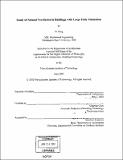| dc.contributor.advisor | Qingyan Chen. | en_US |
| dc.contributor.author | Jiang, Yi, 1972- | en_US |
| dc.contributor.other | Massachusetts Institute of Technology. Dept. of Architecture. | en_US |
| dc.date.accessioned | 2005-08-23T20:44:58Z | |
| dc.date.available | 2005-08-23T20:44:58Z | |
| dc.date.copyright | 2002 | en_US |
| dc.date.issued | 2002 | en_US |
| dc.identifier.uri | http://hdl.handle.net/1721.1/8512 | |
| dc.description | Thesis (Ph.D.)--Massachusetts Institute of Technology, Dept. of Architecture, 2002. | en_US |
| dc.description | Includes bibliographical references (p. 186-194). | en_US |
| dc.description.abstract | With the discovery of many economic, environmental, and health problems in sealed and mechanically ventilated buildings, the concept of natural ventilation has been revived. "Buildings that breathe" have become more and more desired by ordinary people and architects. Although natural ventilation is conceptually simple, it is difficult to design and control. At present, methods to study natural ventilation are either inaccurate or costly. This study aims at solving these problems by using large eddy simulation (LES). In LES, a three-dimensional, time-dependent method, the contribution of the large, energy-carrying structures is computed directly and only the smallest scales of turbulence are modeled. This investigation has identified a filtered dynamic subgrid-scale model of LES to study natural ventilation. The experimental data from a wind tunnel, a full-scale test chamber, and other research data have been used to validate the LES program. Methods have been developed to solve the problems encountered in validating LES models for natural ventilation studies. Studying the characteristics of different indoor and outdoor airflows helps to identify the best SGS model for those flows. By comparing the results of using large and small computational domains, an appropriate domain size is recommended to save computing time. It is also found that simulating the transient properties of incoming wind, such as the principal frequency of the turbulent fluctuations, influences the pressure distributions around buildings. | en_US |
| dc.description.abstract | (cont.) The mechanism of natural ventilation is investigated using the numerical and experimental results. The fundamental impact of turbulence characteristics on ventilation rate is discussed and a new definition to calculate the ventilation rate is introduced. The distributions of velocities, pressures, temperature and energy spectra, and the computed ventilation rates, suggest that natural ventilation performance is significantly affected by thermal conditions and geometry of a building. LES provides the best tool to predict the effects under those conditions. Finally, with the implementation of a Lagrangian particle model, LES is applied to compute particle dispersion in buildings, which provides valuable information to improve indoor air quality. Good results were found for particles larger than 10 micrometers. Further work is needed for smaller particles. | en_US |
| dc.description.statementofresponsibility | by Yi Jiang. | en_US |
| dc.format.extent | 196 p. | en_US |
| dc.format.extent | 14924874 bytes | |
| dc.format.extent | 14924631 bytes | |
| dc.format.mimetype | application/pdf | |
| dc.format.mimetype | application/pdf | |
| dc.language.iso | eng | en_US |
| dc.publisher | Massachusetts Institute of Technology | en_US |
| dc.rights | M.I.T. theses are protected by copyright. They may be viewed from this source for any purpose, but reproduction or distribution in any format is prohibited without written permission. See provided URL for inquiries about permission. | en_US |
| dc.rights.uri | http://dspace.mit.edu/handle/1721.1/7582 | |
| dc.subject | Architecture. | en_US |
| dc.title | Study of natural ventilation in buildings with large eddy simulation | en_US |
| dc.title.alternative | Study of natural ventilation in buildings with LES | en_US |
| dc.type | Thesis | en_US |
| dc.description.degree | Ph.D. | en_US |
| dc.contributor.department | Massachusetts Institute of Technology. Department of Architecture | |
| dc.identifier.oclc | 50775311 | en_US |
